Expert’s Rating
Pros
- Attractive, sturdy design
- Huge touchpad
- Enjoyable speakers with good volume
- Strong CPU and GPU performance
Cons
- Mediocre keyboard
- No Ethernet
Our Verdict
Razer’s Blade 16 backs up its stunning looks with athletic performance, but a few issues keep it from a podium finish.
Price When Reviewed
$4,199
Best Prices Today: Razer Blade 16
The Blade is an institution. Razer was arguably the first laptop manufacturer to re-discover the benefits of building a Windows laptop with an attractive chassis and consistent user experience, and the company has remained committed to that mission ever since. The Blade 16, which is the middle child of the Blade line-up, also delivers excellent performance. It’s not a perfect laptop, though, and owners will need to accept a few flaws.
Looking for more gaming laptop options? Check out PCWorld’s roundup of the best gaming laptops available right now.
Razer Blade 16: Specs and features
I initially received the Razer Blade 16 in Mercury White with an Intel Core i9-149000HX processor and Nvidia RTX 4070 mobile graphics. It also has a dual-mode Mini-LED display that can achieve either (roughly) 4K resolution at 120Hz or 1080p resolution at 240Hz.
Unfortunately, the Mini-LED display on that model was malfunctioning. Razer replaced it with a Blade 16 in Black with the same Intel processor, Nvidia RTX 4090 mobile graphics, and a 2560×1600 240Hz OLED display. The replacement also had a RAM upgrade from 16GB to 32GB. I’ve listed the specifications for both below, when they differed, and this review considers both configurations.
- CPU: Intel Core i9-14900HX
- Memory: 16GB DDR5 5600MHz / 32GB DDR5 5600MHz
- Graphics/GPU: Nvidia RTX 4070 mobile / Nvidia RTX 4090 mobile
- Display: Dual-Mode 3840×2400 120Hz / 1920×1200 240Hz Mini-LED / 2560×1600 240Hz OLED
- Storage: 2TB PCIe NVMe
- Webcam: 1080p with IR camera, privacy shutter
- Connectivity: 1x Thunderbolt 4 with USB-C, 1x USB-C 3.2 Gen2, 3x USB-A 3.2 Gen2. HDMI 2.1, 3.5mm combo audio, SD Card reader
- Networking: Wi-Fi 7, Bluetooth 5.4
- Biometrics: Windows Hello facial recognition
- Battery capacity: 95.2 watt-hours
- Dimensions: 13.98 x 9.61 x 0.87 inches
- Weight: 5.4 pounds
- MSRP: $3,299 / $4,199 as-tested, $2,999 to start
The RTX 4070 configuration I tested was close to the most affordable model available from Razer. All 2024 model year Blade 16 laptops have an Intel Core i9-14900HX processor, but more expensive variants may equip up to Nvidia’s GeForce RTX 4090, which ups the price to at least $4,199. Additional options offer up to 8TB of SSD storage and 96GB of DDR5 memory.
Razer Blade 16: Design and build quality
IDG / Matthew Smith
The Razer Blade’s look and feel is a known quantity. Much like Apple’s MacBook Pro, you can expect particular elements across generations. That means a rigid chassis milled from a single block of aluminum, a professional and elegant aesthetic, and super-slim display bezels.
I personally prefer the “Mercury White” colorway which, though more silver than white, looks fantastic. It reminds me of older MacBook Pro models which, to my eyes, have a particular shade of silver the new models don’t quite replicate. The Black colorway is less exciting but, once again, it looks different from competitors. There’s an inky, abyssal, no-light-escapes quality to Razer’s unique shade of black.
It’s details like these that separate Razer from most of its competition. The aluminum chassis is exceptionally rigid, allowing only the slightest flex across the display and none across the lower body. Material quality feels high, too, with a soft-matte finish that’s pleasing to the touch. Razer also uses an underslung display hinge which spans most of the display’s width, a design element that minimizes the laptop’s footprint and keeps the size of the bottom display bezel to a minimum.
Don’t get me wrong: this isn’t a small laptop. The Razer Blade 16 is almost 14 inches wide and 9.6 deep, as well as close to nine-tenths of an inch thick. It tips the scales at 5.4 pounds. You will notice this laptop in your backpack or messenger bag. With that said, its size is moderate for its capabilities. It’s thicker than a Dell XPS 16, for instance, but slightly more narrow. And, crucially, the Blade 16 should fit in the majority of backpacks, bags, and luggage with a laptop compartment.
Razer Blade 16: Keyboard, trackpad
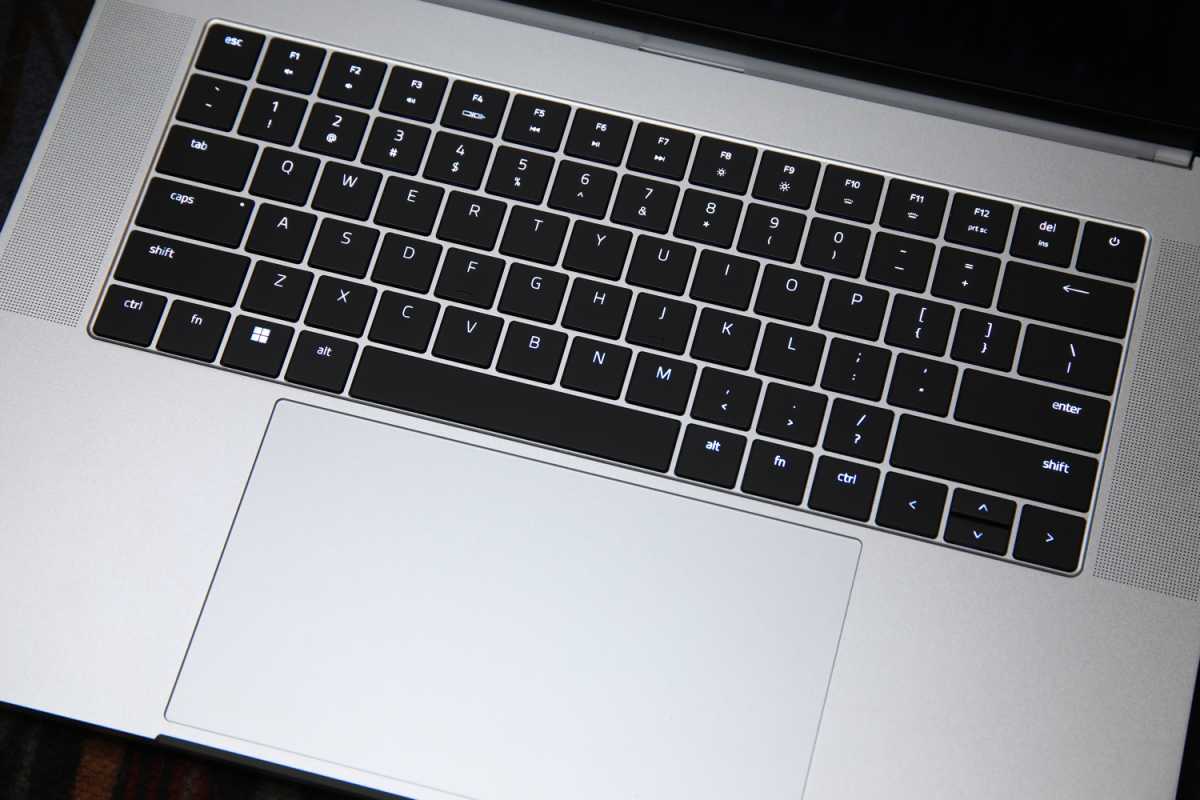
IDG / Matthew Smith
A spacious keyboard with per-key RGB backlight is centered in the Blade 16’s interior. It ditches the numpad to keep the keyboard aligned over the touchpad and ensure the keys are as large as possible. While that’s obviously not great if you need a numpad, this is my preferred layout for a modern laptop. It allows for quick, easy, comfortable touch-typing at high speeds.
Key feel is just ok. Travel feels a bit shallow and ends in a firm and definitive bottoming action. It’s not bad, but it’s stiff and wooden compared to many high-end laptops, including less expensive options like the Lenovo Yoga Pro 9i. Laptop keyboards have improved significantly over the past five years, and Razer is now behind the curve.
The RGB backlight allows per-key color customization, as mentioned, and it works fantastically well. Razer’s secret sauce is its software, Synapse, which controls system settings. Synapse is more attractive and easier to use than competitors’ software, which is important, and it of course ties into Razer’s Chroma ecosystem, so it can coordinate with other Razer Chroma compatible devices, as well as those compatible with Dynamic Lighting on Windows 11, which Chroma supports.
But the touchpad is the star of the laptop’s user interface. It’s a massive piece of glass that’s over six inches wide and almost four inches deep. The touchpad’s large, smooth surface makes Windows multitouch gestures easy to execute and allows for speedy scrolling through web pages and documents. I like the touchpad so much that I prefer to use it over a mouse in many situations though, of course, it’s still necessary to break out a mouse when it’s time to play PC games.
Razer Blade 16: Display, audio
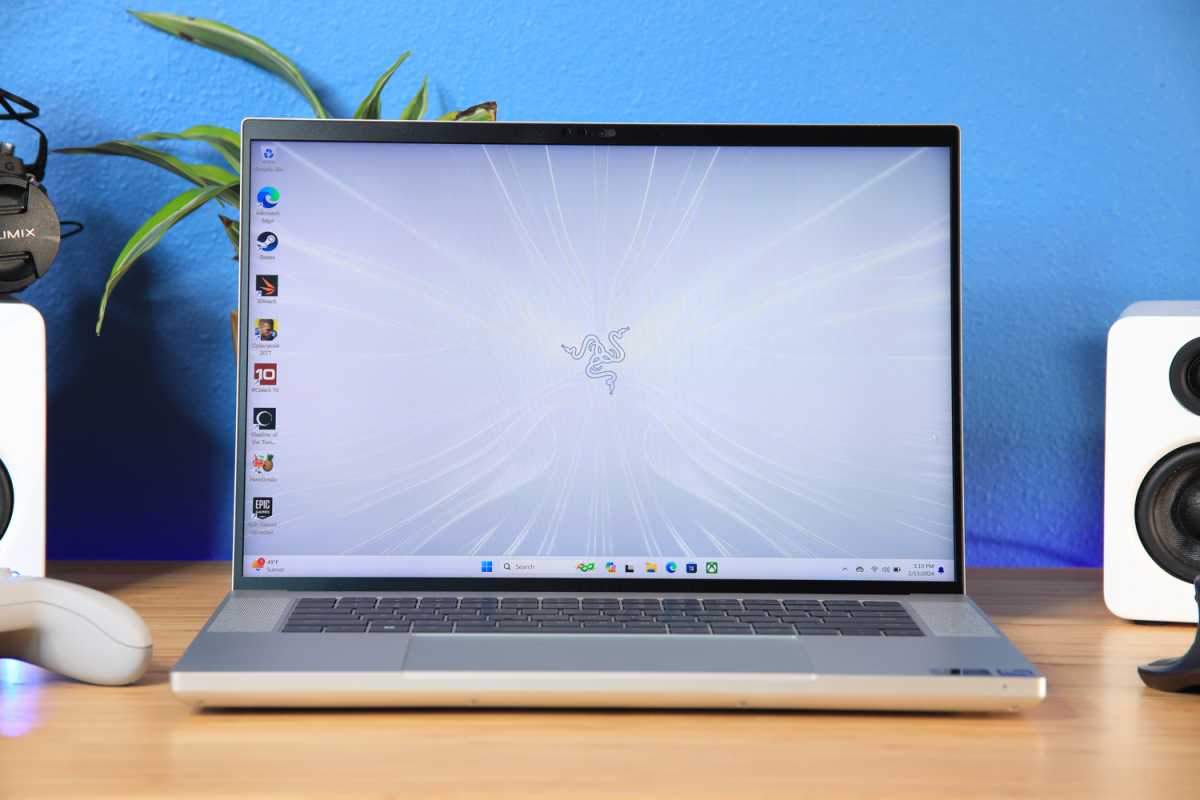
IDG / Matthew Smith
Razer initially sent me a Razer Blade 16 with a 3840×2400 / 1920×1200 dual-mode Mini-LED display. It’s a cutting-edge display with a dynamic backlight and the unusual ability to flip between 4K and 1200p resolution. 4K can achieve a refresh rate of up to 120Hz, while 1200p can hit up to 240Hz. The dual-mode feature makes it equally useful in games with top-tier visuals, where the 4K mode provides maximum sharpness, and in esports titles, where a refresh rate of 240Hz can improve responsiveness and motion clarity.
The Mini-LED display was defective, however, which caused significant motion blur even when scrolling through a website. Razer blamed it on early firmware and said it required an update by the company’s engineers. But Razer never sent that laptop back and hasn’t explained precisely why the Mini-LED model was not returned, which worries me. I don’t recommend the dual-mode Mini-LED display.
Razer replaced the defective Blade with a more powerful laptop with a 2560×1600 240Hz OLED display, which is fantastic. It delivers a deep, immersive image with vibrant and accurate color. And while the display’s resolution isn’t as sharp as a 4K panel, it still packs 188 pixels per inch and looks crisp when enjoying games, movies, and YouTube. Motion clarity is excellent, too, thanks to the 240Hz refresh rate and OLED’s low pixel response times.
Every Blade 16 ships with a beefy sound system that includes two upwards-firing tweeters and two subwoofers. It delivers great volume and robust sound with a reasonable hint of bass in music and action-packed games. The presentation can begin to feel harsh at higher volumes but, even so, the Blade 16’s sound should work for watching Netflix and most games.
Razer Blade 16: Webcam, microphone, biometrics
A 1080p webcam tucks into the Blade 16’s top bezel. It’s much better than average with a sharp image, good color reproduction, and excellent behavior in high-contrast situations that usually fool a webcam’s automatic exposure. You’ll look excellent in video calls, and while I wouldn’t say the camera is great for streaming or YouTube, you could do worse.
The microphone sounds great with strong volume and a reasonably full presentation that partially avoids the hollow, distant sound typical of laptop webcams. It should work for any video call.
Biometric login is provided through Windows Hello facial recognition. It works well with near-immediate facial recognition in a wide variety of lighting conditions. A fingerprint reader is not available.
Razer Blade 16: Connectivity
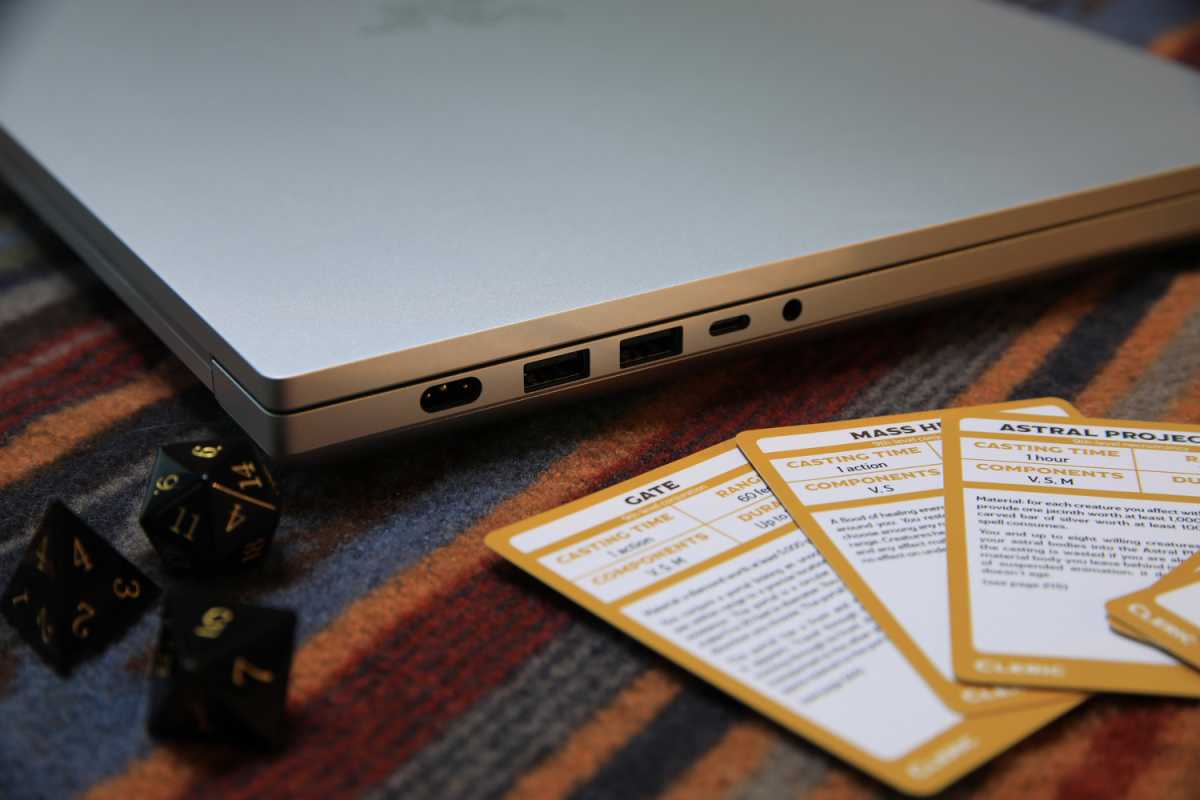
IDG / Matthew Smith
The Razer Blade 16’s connectivity straddles the line between new and old. It offers a total of three USB-A 3.2 Gen 2 ports, but those come alongside one Thunderbolt 4 port and one USB-C 3.2 Gen 2 port. The Thunderbolt 4 and USB-C ports also provide DisplayPort Alternate Mode and up to 100 watts of USB Power Delivery. An HDMI 2.1 port, SD Card reader, and 3.5mm combo audio jack round out the options.
All of the ports are found along the laptop’s flanks, which differs from many 16-inch gaming laptops. It’s common for many such machines to place some ports on the back, which helps with cable management. But as mentioned earlier, the Blade 16’s display hinge is placed at the bottom rear of the chassis, rather than the top, which means the rear is not available for ports. Razer smartly places most ports near the rear of each flank, though, so cable management remains fairly easy.
There is just one wired port missing, and that’s Ethernet. I’m surprised by its absence, as there’s room for it, but I’m also not too bothered. There’s plenty of ports available for using an adapter when Ethernet is required.
It helps that the Blade 16 supports the latest Wi-Fi 7 standard as well as Bluetooth 5.4. This is the cutting edge in modern wireless networking—so much so that most people, myself included, do not yet have a compatible router. My router does support Wi-Fi 6E, however, and I observed blistering download speeds up to (and slightly over) 800 MB/s over my home Internet connection, which is capped at a gigabit.
Razer Blade 16: Performance
As my first Blade 16 had to be returned, and the second was different from the first, I was able to test the performance of Blade 16 configurations. They shared an Intel Core i9-14900HX processor and 2TB PCIe NVMe solid state drive. The Mercury White model had 16GB of RAM and Nvidia RTX 4070 mobile graphics, while the Black mode had 32GB of RAM and Nvidia RTX 4090 mobile graphics.
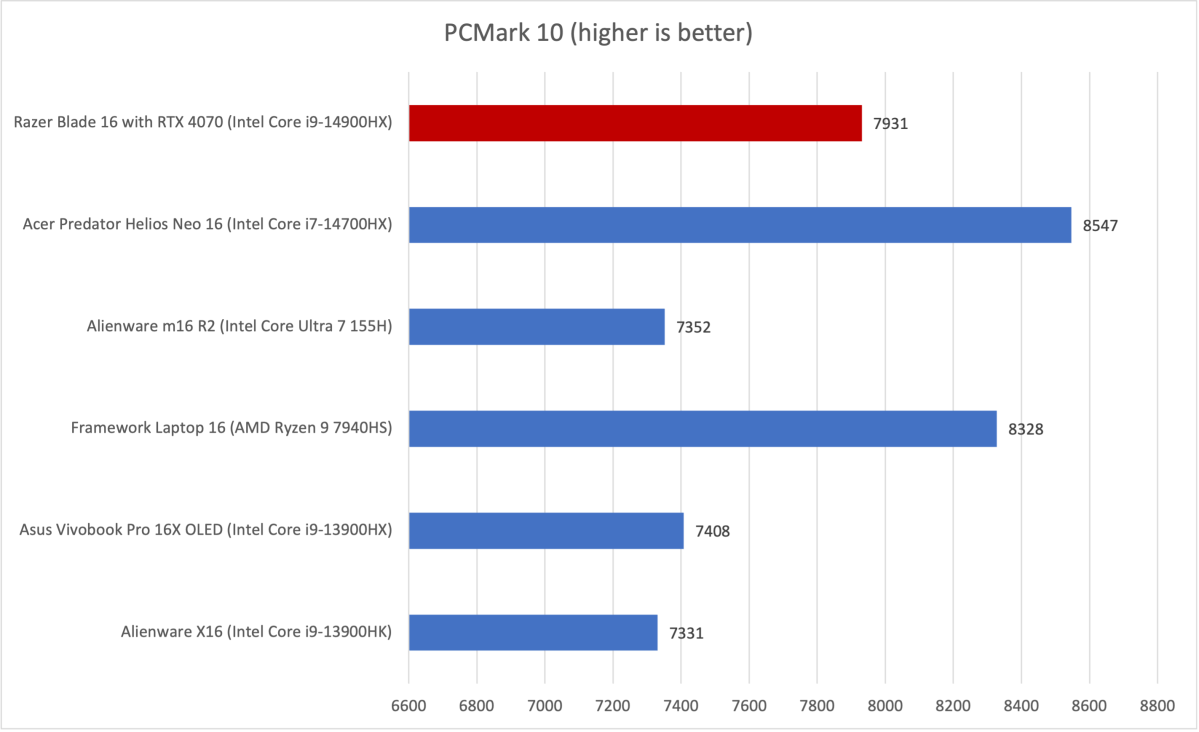
IDG / Matthew Smith
We kick things off with PCMark 10, a board system benchmark. Unfortunately, the Blade 16 with RTX 4090 graphics froze halfway through this benchmark, so I wasn’t able to complete the test with that configuration. I don’t think this represents an issue with the Blade 16, as PCMark 10 can fail from time to time, and I had no other performance or stability issues with the laptop.
The Blade 16 with RTX 4070 finished PCMark 10, however, and hit a respectable score of 7,931. That’s not going to set records, but it’s very much in line with what I would expect. The Razer Blade 16 is only slightly behind larger, more expensive laptops with the same processor, such as the MSI Titan 18 HX.
There is one surprise here, and that’s the Framework Laptop 16. It performed extremely well in this test, beating not only the Razer Blade 16. However, the rankings shift when we switch to other benchmarks.
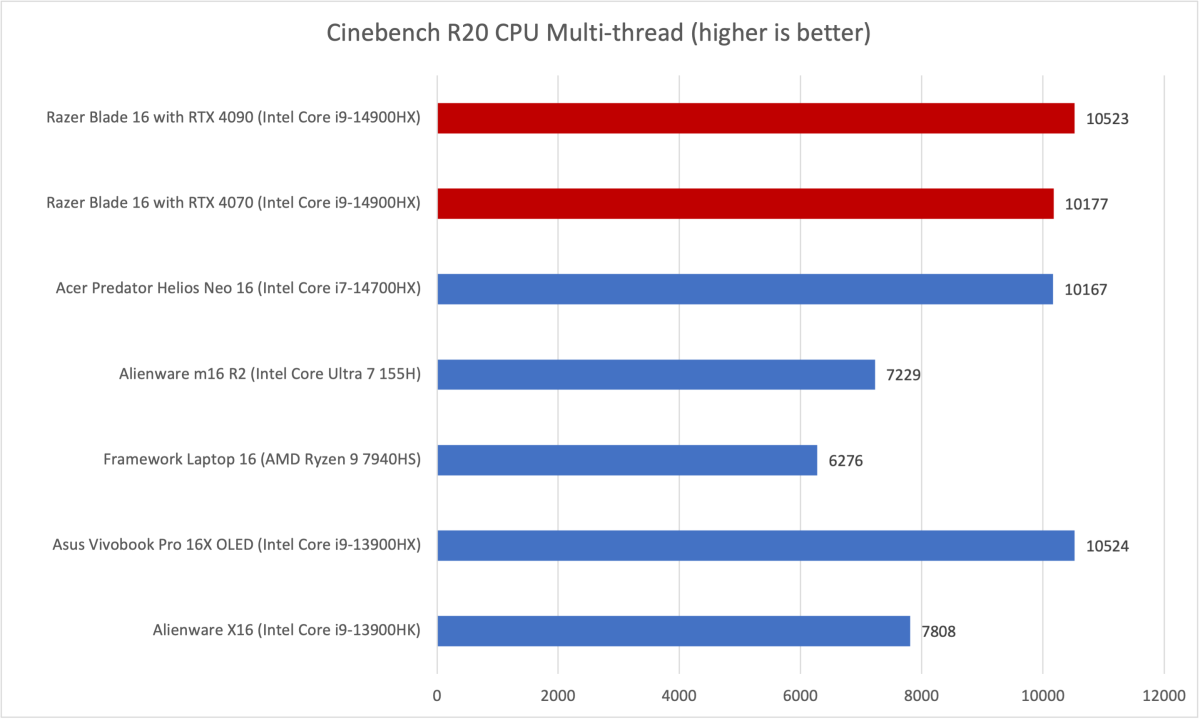
IDG / Matthew Smith
Cinebench R20 is a heavily multithread, short-duration CPU test, and it places the Razer Blade 16 in a good spot. Both Blade 16 models I tested had performance that is similar, though behind, larger competitors with the same processor. The Blade 16 also outperforms the Framework Laptop 16 and the 2023 model of the Alienware X16 in this benchmark.
The Asus Vivobook Pro 16X OLED does manage to rival the Blade 16, however. That may seem surprising, but our tests of Intel Core i9-14900HX processors so far indicate the 14th-gen’s advantage over the 13th-gen is rather slim, and the Vivobook Pro 16X OLED’s performance was strong for a laptop with that processor.
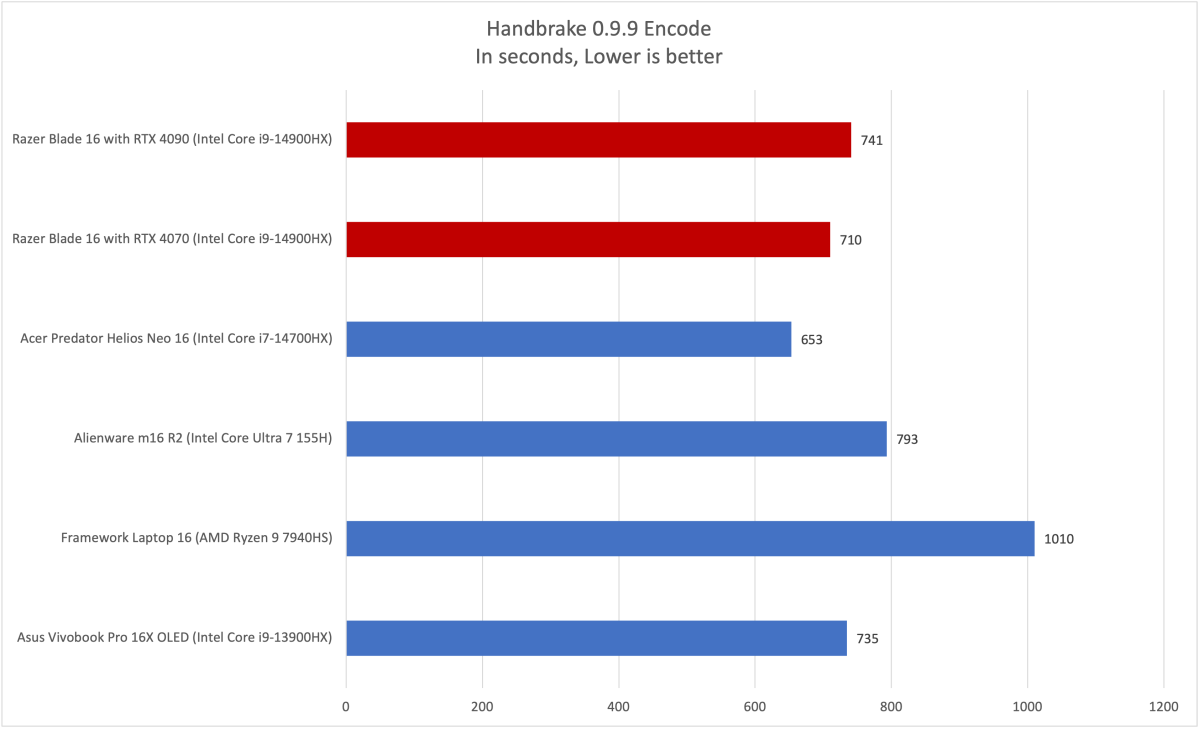
IDG / Matthew Smith
Handbrake is a heavily multithreaded, long-duration CPU test in which we transcode a 1080p movie. Here the Blade 16 retakes the lead over the Asus Vivobook Pro 16X OLED and dominates the Framework Laptop 16 which, remember, has an AMD Ryzen 9 7490HX processor. The Acer Predator Helios Neo 16 scored a win, however, defeating both Blade 16 configurations.
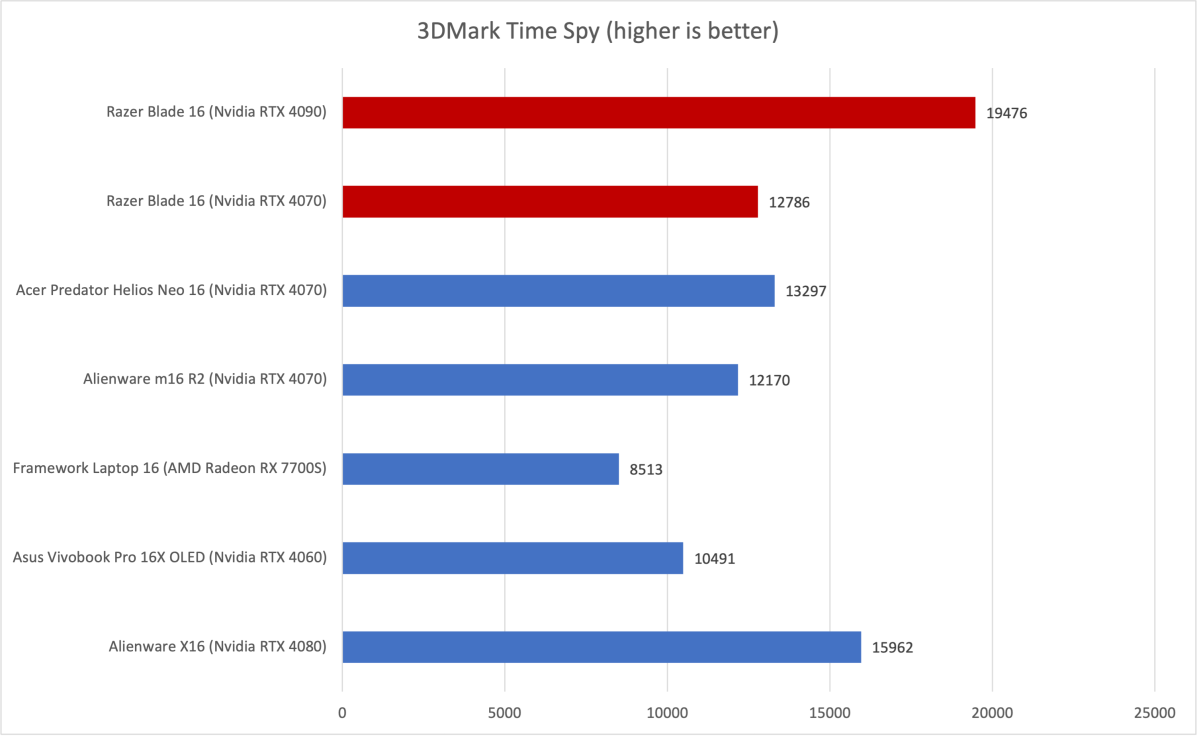
IDG / Matthew Smith
Now we switch to GPU-heavy benchmarks. Here, the differences between the two Blade 16 models I tested are obvious.
The Blade 16 with RTX 4070 is rather quick and reached a score of 12,786 in the 3DMark Fire Strike Test. That’s right between the Asus Vivobook Pro 16X OLED with Nvidia RTX 4060 and the Alienware x16 with Nvidia RTX 4080. The Blade 16 with RTX 4090 soars to a score of 19,476—a roughly 50 percent improvement over the RTX 4070. That’s competitive with other RTX 4090 laptops we’ve recently reviewed.
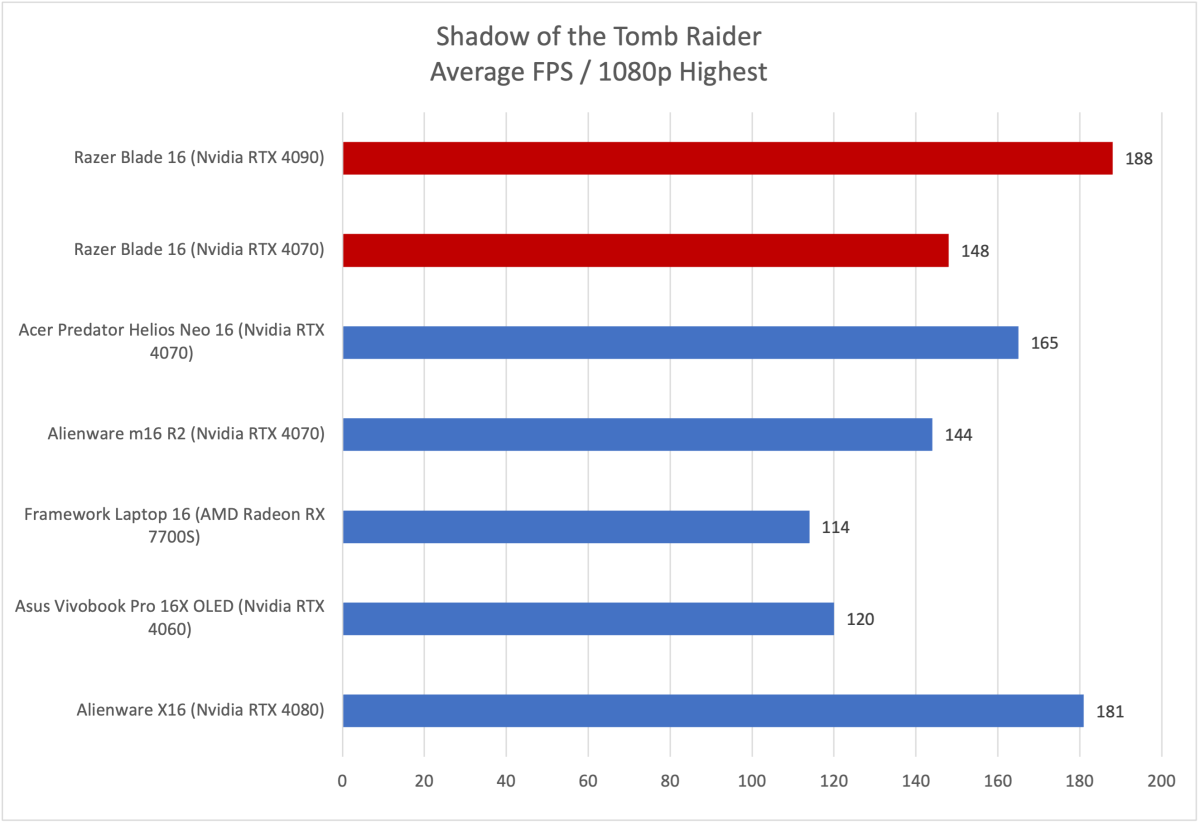
IDG / Matthew Smith
Real-world game performance is a similar story, as the Razer Blade 16 achieved an average of 148 frames per second in Shadow of the Tomb Raider at 1080p resolution and Highest detail. That’s again between an RTX 4060 and RTX 4080. It’s also, of course, a highly playable and smooth experience. The RTX 4090 boosted the framerate to 188 FPS, which is higher, but less of an improvement than in 3DMark Time Spy.

IDG / Matthew Smith
I was only able to test the Blade 16 with RTX 4090 in Metro Exodus, as I had to return the RTX 4070 model before I could complete my test. The Blade 16 performed well, however, with an average of 84 FPS. That’s definitely towards the upper end of typical performance in this game and competitive with other RTX 4090 laptops.
I also tried Cyberpunk 2077 at 1080p resolution. The Blade 16 with RTX 4070 averaged 84 frames per second at the Ultra detail pre-set with Ray Tracing turned off, while the Blade 16 with RTX 4090 achieved 118 FPS—a significant gain.
The RTX 4070 model struggled at 1080p with the Ray-Traced Overdrive preset and reached an average of just 22 frames per second (with DLSS off). The RTX 4090 improved on that significantly and achieved a playable 38 FPS (again, with DLSS off). It’s not the ideal experience, but it’s tolerable.
All of the results above were achieved in the laptop’s Turbo performance profile, which is the default. It’s important to note that while the profile is labeled “Turbo,” which would seem to imply it’s a special high-performance mode, the Blade 16’s behavior in this mode is more like a Balanced or Standard mode on other 16-inch laptops. Fan noise is obvious but usually livable.
I also tested the Blade 16 in a custom performance configuration that overclocked the processor. It significantly boosted performance in some benchmarks, especially on the Blade 16 with RTX 4070; the Cinebench R20 score increased from 10,177 to 11,069, for example, which is roughly a 10 percent gain. I saw similar or slightly greater gains in Handbrake and 3DMark Time Spy. The fan was extremely loud in this mode, though, so I don’t recommend it unless you plan to start a long-duration task (like encoding a video) and leave the room.
Razer Blade 16: Battery life
Razer stuffs a large 95 watt-hour battery into the Blade 16. That’s quite large, but it ran into difficulties in our standard battery test.

IDG / Matthew Smith
The Blade 16 with RTX 4070 endured our standard battery test, which loops a 4K file of the short film Tears of Steel, for over four hours. The RTX 4090 reduced battery life to roughly two and a half hours. Neither result is impressive.
There is some nuance here. The Blade 16 supports Nvidia Optimus, which means the GPU can hand graphics rendering over to the Intel processor’s integrated graphics to save power. Optimus can be finicky, though, and may at times leave the GPU activated when it’s not required. The hand-off wasn’t always smooth, either, and at times caused the screen to freeze completely for several seconds.
Real-world battery life was often better than our benchmark results, but not by much. I used the Blade 16 with RTX 4070 to play a tabletop role-playing game for four hours and saw the battery drained from 100 to roughly 35 percent. Most of that time was spent viewing web pages and PDFs.
Razer Blade 16: Conclusion
The Razer Blade 16 is an attractive and speedy gaming laptop with a slim footprint and good connectivity, but a few flaws soured my impression. Razer’s Mini-LED display was defective due to a firmware issue, and while I was sent a model with an excellent OLED display as a replacement, I was never sent a second Mini-LED display to test. The Blade 16 would also benefit from a better keyboard and additional battery life optimization. Razer’s mid-size laptop is a good choice if you want strong CPU and GPU performance in a sleek, attractive Windows laptop but, given the price, I’d expect a more consistent experience.


